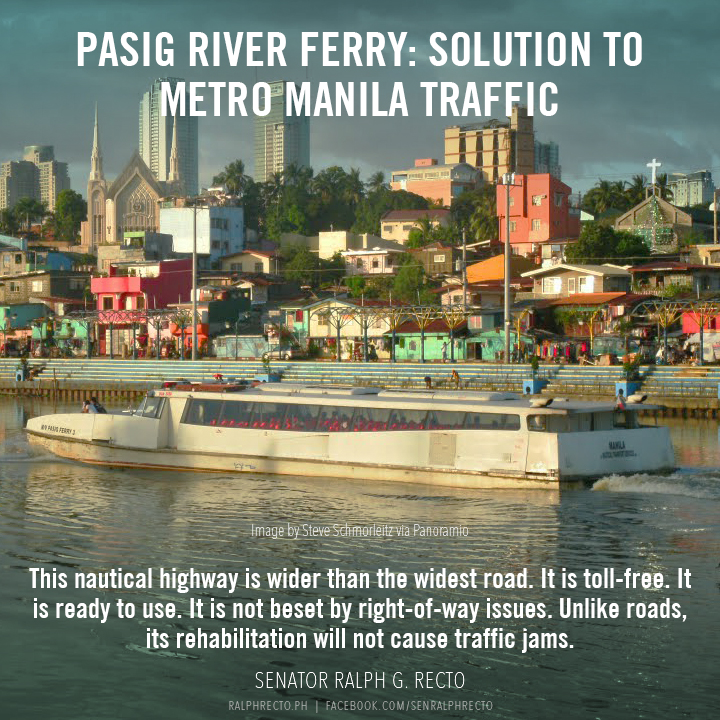‘Pasig River duty for rogue cops must help not just Digong’s boat but ferry project’
The plan of Philippine National Police Director General Ronald dela Rosa to assign 387 erring Metro Manila cops to rid Pasig River of water lilies has gotten the backing of Senate Minority Leader Ralph Recto.
But Recto said the policemen’s Pasig River mission should go beyond clearing the waterway for President Duterte’s tugboat to cross smoothly from his Bahay Pangarap residence to the Malacañang Palace, “to readying the ‘nautical highway’ for the resumption of the ferry service.”
“It should not be a mission for the convenience of one person, but for thousands of people who will stand to benefit if this alternative commuting route to Manila’s traffic-choked streets will be reopened,” Recto said.
Dela Rosa today ordered the regional director of the National Capital Region Police Office to bring some 300-plus policemen to Camp Crame so he can escort them to Malacañang, which is along Pasig River.
The PNP chief’s order is in compliance with Duterte’s directive that he wants policemen facing disciplinary action to be assigned to Malacañang, an about-face from his standing order to send them to Muslim Mindanao areas.
Recto said that by assigning them to Pasig River duty, “we can have a battalion-size environmental police force that can clean one of Asia’s most polluted rivers.”
“Sending dirty cops to a dirty river is not a punishment. Kahit literal na tinapon sila sa kangkungan, it is a good mission. By being there, they will be able to clean not just the river, but also their reputations. I hope that by the end of their tour, both them and the river will come out smelling like roses,” Recto said.
He said Dela Rosa’s order will focus government attention to a neglected resource that is the Pasig River “and start discussions on how it can help ease Metro Manila’s traffic.”
One of the solutions to our traffic “is the one in between the President’s office in Malacañang and the President’s bedroom in Bahay Pangarap.”
In a proposal to Congress, the Department of Transportation is asking for P2.7 billion to rehabilitate and refleet the mothballed Pasig River ferry service.
Listed under “maritime sector” of DOTr’s master plan are five projects worth P2.65 billion, including the purchase of 20 100-passenger vessels at a cost of P400 million and the rehabilitation of 10 passenger terminals at a cost of P40 million.
Recto said the cost of reviving Pasig River as “a people mover is less compared to the expensive land-based solutions like trains and elevated expressways.”
“This nautical highway is wider than the widest road. It is toll-free. It is ready to use. It is not beset by right-of-way issues. Unlike roads, its rehabilitation will not cause traffic jams,” Recto said.
“There is no need to import trains and wait years for their delivery because the boats can be procured locally, from Cavite, Batangas, Bataan, and Cebu, where there is a thriving shipbuilding industry,” Recto said.
Before the 10-boat Pasig River ferry service stopped operations in 2011, it served 17 stations along a 15-kilometer route from Plaza Mexico in Intramuros, Manila to Nagpayong in Pasig City.
Another spur, using the Marikina River, from the Riverbanks in Marikina City to Guadalupe in Makati City, was planned, but except for trial runs, no regular service was launched.
Recto said the revived service must reach Marikina so Rizal and Quezon City residents would have a recourse from road gridlocks.
The last ferry operator deployed twin-hulled boats which seat 150 people in air-conditioned cabins. Low passenger volume and navigational hazards like the proliferation of water lilies soon led to its discontinuation.



